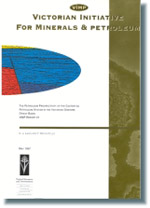VIMP Report 41 - The petroleum prospectivity of the Casterton Petroleum System in the Victorian onshore Otway Basin
 |
| |||||
Product description:Download The downloadable version of this report is supplied in PDF format. Executive Summary In April 1997, the State Government of Victoria gazetted three areas of the onshore Otway Basin. In order to assist companies with the evaluation of two of these areas, this report summarises the petroleum prospectivity with respect to the Early Cretaceous play fairways, and particularly the Casterton Group Petroleum System, which contains the most important targets in the northern part of the onshore Otway Basin. The Casterton Group is a Late Jurassic–Earliest Cretaceous, dominantly shaly unit developed at the base of early syn-rift graben throughout the Otway Basin. This unit is the key hydrocarbon source rock interval in many of the northern margin basins. To date, very little has been published discussing its source rock potential and relationship with other play fairway elements. In the gazetted areas, well data from within the depocentres is not available, so seismic data and well control from nearby areas have been used to demonstrate the petroleum potential. The areas investigated with respect to the Casterton Petroleum System all have the elements required to host hydrocarbon accumulations sourced from the Casterton Group. Both VIC/O97(1) and VIC/O97(2) are likely to contain Neocomian sands of the Crayfish Group that are, to date, untested in Victoria, although this play type has been successfully targeted in the Penola Trough in South Australia. Wells immediately adjacent to the gazetted areas have recovered oil shows from these sands. The principal play type in the two areas is defined—Crayfish Group sandstones, sealed by intraformational mudstones, capable of hosting hydrocarbons (potentially both oil and gas) derived from lacustrine shales in the Casterton Group. Trap development, principally tilted fault blocks, occurred primarily during the waning phases of rifting in the Aptian; prospective tilted fault blocks also developed after this period in the Tantanoola Trough. Generation and migration occurred predominantly during the Aptian and Albian, with additional potential for migration during the Late Cretaceous and Tertiary in the Tantanoola Trough. Bibliographic reference Lavin, C.J. & Muscatello, T., 1997. The petroleum prospectivity of the Casterton Petroleum System in the Victorian onshore Otway Basin. Victorian Initiative for Minerals and Petroleum Report 41. Department of Natural Resources and Environment. | ||||||

